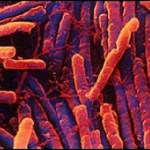diarrhea
Image of C. difficile from BBC News.
You may recall a prior post about a dog that could smell when patients were infected with Clostridium difficile. C. difficile causes about 14,000 deaths per year in the United States. Recent breakthroughs in understanding gut microbes have led to the successful treatment of C. difficile in patients. Fecal transplants, the transfer of feces from a healthy person, has been life-saving for some patients for whom medical treatments are not effective or for recurrent infections. Listen to Billie's story here. To date, feces have been…
This is the fourteenth of 16 student posts, guest-authored by Caroline Rauschendorfer.
Cryptosporidiosis, known more commonly as crypto, is a gastrointestinal (GI) disease caused by parasites of the Cryptosporidium genus. If infected with crypto you may experience diarrhea, nausea, vomiting, fever, and abdominal cramps that can last up to two weeks. Definitely something you want to avoid, if possible, but at least it usually resolves on its own without medical intervention and is rarely fatal in otherwise healthy individuals. [3]
The most common disease causing organisms for…
By Jay Graham
Global Handwashing Day is coming up on October 15, and events in its honor will be occurring all week. Children are a key focus of handwashing campaigns. Diarrhea continues as the second leading cause of death in kids under 5 years of age globally. Nearly one in every five child deaths, around 1.5 million a year, is due to diarrhea. It kills more children than AIDS, malaria, and measles combined - more than 4,000 children dying every day.
So, why Global Handwashing Day? Handwashing may be the single most cost-effective public health intervention ever. In a systematic review,…
Mike has has a great new post up looking at some molecular analyses of the current European outbreak strain. For anyone who hasn't been paying close attention to what's happening across the pond, there's an ongoing outbreak of enterohemorrhagic E. coli (EHEC)--the type of E. coli that includes O157:H7, which has been associated with outbreaks of disease associated with food. The most infamous outbreak was the 1993 Jack-in-the-Box disaster, associated with undercooked hamburgers contaminated with the organism, but there have also been outbreaks associated with contaminated vegetables (such as…
Flooding in Pakistan has killed 1,600 and is affecting an estimated 20 million people. Six million lack access to food, shelter, and water. The report of a single confirmed cholera case (in the Swat valley) is generating some headlines, but the important point is that a lack of clean water makes the spread of any diarrheal disease far more likely.
UNICEF warns that "more than 3 million children are at high risk of deadly water-borne diseases in Pakistan," and cites a WHO projection of up to 1.5 million cases of diarrheal diseases that could occur over the next three months. These aren't just…
Mark Pendergrast writes: To kick off this book club discussion of Inside the Outbreaks, I thought I would explain briefly how I came to write the book and then suggest some possible topics for discussion.
The origin of the book goes back to an email I got in 2004 from my old high school and college friend, Andy Vernon, who wrote that I should consider writing the history of the EIS. I emailed back to say that I was honored, but what was the EIS? I had never heard of it. I knew Andy worked on tuberculosis at the CDC, but I didn't know that he had been a state-based EIS officer from 1978…

